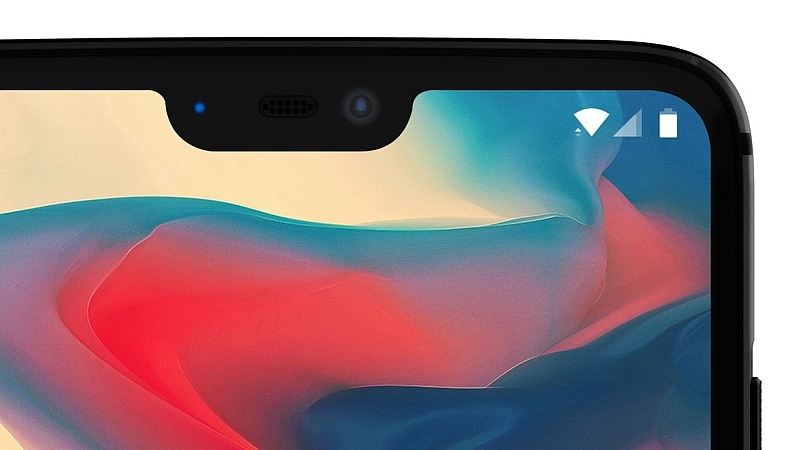- Home
- Mobiles
- Mobiles Features
- OnePlus 6, Black Shark, Jio vs Airtel, Google Home, and More News This Week
OnePlus 6, Black Shark, Jio vs Airtel, Google Home, and More News This Week

OnePlus 6 continues to be in the news
Welcome back to our weekly recap of all the tech news that you can use. Just like last week, the OnePlus 6 captured a lot of attention this week as well, and the design was revealed in an official teaser that compared it to the OnePlus 5T. In the teaser, you can see the see the left edge of the phone, which isn't a lot, but a close look gives enough hints to suggest a glass back, which could mean the OnePlus 6 will support wireless charging, and also different placement for the alert slider, which another leak suggests could get a slide to focus function for photography.
Meanwhile, the leaks continued as well, and the design of the phone showing the notch was spotted online. Leaked case renders also gave away a bit more of the OnePlus 6 design, showing the vertical camera layout on the rear and the notch on the front. At this point, the design of the phone seems to be pretty clear, and this is likely to be confirmed soon with the launch around the corner.
OnePlus 6 Launch Expected Soon: Price, Specifications, Features, and More
We also got a look at the colour variants - leaked renders show that the OnePlus 6 will come in blue, white, and black models, although given the edge-to-edge display on the front - save for the notch - the colour is something that you'll only see on the back of the phone, obviously. Another leak also "confirmed" that the OnePlus 6 will be launching in an Avengers: Infinity War edition, as previously teased, with a Snapdragon 845 SoC, 8GB of RAM, and 256GB inbuilt storage.
It was also a big week for Xiaomi. The Chinese company has backed a new gaming phone, the Black Shark, which launched on Friday in China. Ahead of that, a leaked live image had already revealed the dual-rear-camera setup, along with the ergonomic curves on the back. A leaked video, and a teaser at the start of the week, showed more of this design, which was confirmed at the launch. The Black Shark, which does not bear Xiaomi branding, has a unique look and comes with a 5.99-inch full-HD+ 18:9 aspect ratio display. The phone and case were launched in China, with the phone starting at CNY 2,999 (roughly Rs. 31,100), while the 8GB/ 128GB variant will set you back by CNY 3,499 (roughly Rs. 36,300).
The Black Shark is powered by the Snapdragon 845 SoC, with either 6GB RAM/64GB storage, or 8GB RAM/ 128GB storage, and packs a 4000mAh battery. The smartphone has a dual-rear camera setup with a 20-megapixel sensor and a 12-megapixel sensor, and a 20-megapixel sensor for the front camera. The brand also announced a controller case/ dock for the Black Shark, which adds a joystick and trigger button, to make gaming easier. The company didn't talk about compatibility with games however, and most controllers have a two joystick design, so it's not entirely clear how well this will work.
Aside from that, Xiaomi also doubled down on its Make in India initiative. It had started assembling some phones in India as early as 2015, and by now almost all its phones are already made in India. Now, it's opened three more smartphone plants in India, and also started manufacturing smartphones at its power bank plant in Noida. It also announced its first SMT (Surface Mount Technology) plant dedicated towards local manufacturing of PCBA (Printed Circuit Board Assembly) units in Sriperumbudur, Tamil Nadu, in partnership with Foxconn. According to Xiaomi, at present, manufacturing in India only accounts for 10 percent of the value of the phone, and with these new plants, it will move to nearly 50 percent.
And if you've been waiting for the latest phone from the company - Xiaomi's sent out invites for the launch of a new smartphone on April 25, and the smart money is on this being the Xiaomi Mi A2/ Mi 6X. In case you're wondering what's up with the name, last year's Mi 5X made its way to Indian shores as the Mi A1. The phone was spotted in an earlier leak promising a 5.99-inch 18:9 aspect ratio display, while another report showed a 2.2GHz octa-core Snapdragon 626 SoC. Further details were spotted in the firmware files, which point to Android 8.1 Oreo being the operating system, and the Snapdragon 660 SoC powering the Xiaomi smartphone.
Finally, there were also some Xiaomi-related rumours that took many by surprise - the Chinese company reportedly plans to acquire GoPro, which remains the market leader for the "action camera" category. Xiaomi also has a product in this category, the Yi action camera, which launched in India last year at Rs. 17,990. And although GoPro is the market leader, it's been going through some tough times of late. In many ways, this brings back memories of 2015, when Xiaomi-backed Ninebot bought Segway, which had been the category creator and defining name at the time.
On the telecom front, Airtel continues to roll out offers. If you're an Airtel user upgrading to a 4G smartphone, you can get 30GB free data right now. This is capped to 1GB per day for 30 days, and this is available to both prepaid and postpaid users, the latter also getting data rollover for unused data. At the same time, it's also catching up to Reliance Jio and BSNL with the launch of its own offer for IPL 2018. Under the new Rs. 249 plan, users get 2GB data per day - and unlimited calling, 100 SMS per day - for 28 days, totalling up to 56GB data.
Jio vs Airtel vs Vodafone vs Idea vs BSNL: Best Recharges Under Rs. 300 Compared
There's also a Rs. 349 pack which gives 3GB data per day, so depending on your usage, you should be able to keep up with streaming the IPL quite easily. In case that wasn't enough, it also announced a new Rs. 499 recharge that gives 164GB data. There's a 2GB daily cap on data use, and 82 days validity, and for calls you get 300 minutes per day up to 1,000 minutes per week bundled. And in case you're looking for a little extra speed at home, Airtel has also launched a 300Mbps broadband plan for FTTH (Fiber-To-The-Home) customers, priced at Rs. 2,199 per month with a FUP limit of 1,200GB data, although availability is limited right now.
Another product that got a lot of attention this week was the Google Home, which launched in India on Tuesday. It was priced at parity with Amazon's smart speakers, with the Google Home priced at Rs. 9,999, while the Google Home Mini is priced at Rs. 4,499, matching the pricing of the Amazon Echo and Echo Dot. However, on the morning of the launch, Amazon announced a deal on its speakers, offering Rs. 3,000 off if you bought two Echo speakers, and Rs. 1,000 off if you bought two Echo Dots.
Like the Echo, you can talk to the Google Home and ask it questions, or have it carry out actions such as controlling your smart home, or booking a cab. It's available via Flipkart, and also various offline retailers, so if you want to get a demo, just head down to the nearest Reliance Digital, Croma, Bajaj Electronics, Vijay Sales, Sangeetha, or Poorvika. According to Google while the speakers do support Indian accents, Hindi support will only come later this year, and there's no mention of other Indian languages.
Also, while the Alexa-powered speakers work with many third-parties like Zomato, UrbanClap, and Ola, Google Home seems to be limited to just a handful - Netflix, Gaana, Saavn, and Google's own core services like YouTube. The company is betting on home automation however, which it predicts is set to grow, though it is a small niche today.
Another launch that was pretty interesting was the Samsung Galaxy J7 Duo, priced at Rs. 16,990. The phone has a 5.5-inch HD display, a 1.6GHz octa-core processor, and 4GB of RAM. There's 32GB storage, and a 3000mAh battery. With this phone, Samsung also introduces a dual-rear-camera to the J series, with a 13-megapixel sensor and a 5-megapixel sensor in the rear, apart from the 8-megapixel selfie camera.
In China, ZTE launched its latest smartphone, the Nubia Z18 mini. It will go on sale from April 19, priced at CNY 1,799 (roughly Rs. 18,700), and comes with a 5.7-inch full-HD+ 18:9 aspect ratio display. There's a Snapdragon 660 SoC, 6GB of RAM, and a 3450mAh battery. It has a 24-megapixel and 5-megapixel dual-rear-camera setup, and an 8-megapixel front camera.
Other launches in India include the Coolpad A1 and Coolpad Mega 4A, which were launched as offline exclusives. The Coolpad A1 is priced at Rs. 5,499, while the Coolpad Mega 4A is priced at Rs. 4,299. Both have 5-inch HD displays, but while the A1 is powered by a Snapdragon 210 SoC, the Mega 4A goes with a Spreadtrum SC9832 SoC. The former has 2GB of RAM, while the latter has 1GB, and the A1 comes with 8-megapixel and 5-megapixel rear and front cameras, compared to 5-megapixel and 2-megapixel for the Mega 4A. Finally, the A1 also packs a bigger battery, at 2500mAh, compared to 2000mAh for the Mega 4A.
Intex launched the Intex Uday, which is priced at Rs. 7,999, and features a 5-megapixel front camera with a selfie flash. The phone has a 5.2-inch HD display, and a 1.3GHz quad-core processor, and 3GB RAM. And Vivo launched it's Vivo Y71 smartphone, which has an 18:9 aspect ratio display, and is powered by the Snapdragon 425 SoC, and 3GB RAM. There's a 13-megapixel rear camera, and a 5-megapixel front camera, and the phone has a 3360mAh battery.
Finally, although it's not a new phone, Apple fans will be interested to know about the launch of the iPhone 8, iPhone 8 Plus (PRODUCT) RED Editions in the US and other markets. The all new iPhone models feature a matte red aluminium finish, are available in 64GB and 256GB variants, and are now up for pre-order. The aim of launching the red variants is to support (RED), an organisation that raises awareness and funds to help combat HIV/AIDS in Africa. India availability of the new colours is expected soon, with pricing same as the existing iPhone models.
There was also some news about the upcoming LG G7 - after last week's leak about the name, it was confirmed as the LG G7 Thinq, and leaked press renders showed five different colour variants. From the renders, the phone appears to have an AI-powered physical button, and a vertical dual camera setup on the rear. The phone, which is set to launch on May 2, features a notch on the front, but this can apparently be hidden, which is also what's expected for the OnePlus 6.
The LG G7 Thinq is said to have two 16-megapixel rear cameras, and it is said to be an HDR10-compatible handset, so it can record HDR10-quality videos as well as play back HDR10 videos. It will reportedly come with a 'Boombox Speaker" that's bigger than the one in the LG G6, and while it will come with the Google Assistant, this will also be capable of carrying out LG-exclusive device specific tasks, according to reports.
Finally, some exciting news for gamers. Although the new God of War is only available from next week, on Friday April 20, the review embargo has been lifted and as you can see from our review, the game is a beast. Despite some issues - including a strange noise problem on the PS4 Pro - the game scores a perfect 10 our judgement.
Some interesting news from India this week as well, as we saw our first major Bitcoin theft. Popular exchange and wallet Coinsecure reported that 438 coins valued at around Rs. 20 crore were siphoned off, possibly by an employee, as noted by the company's CEO in an FIR filed on the matter. The company has promised to indemnify any affected customers, although it's definitely going to hurt the cause of the industry at a time when the RBI seems to want to put an end to cryptocurrency in India.
And, while Goa taxi operators have so far kept Ola and Uber out, the state government is looking to launch its own app-based taxi service. According to a report, the government has invited taxi operators to register with the new service.
Speaking of Ola, the company is continuing its Australian expansion, and has now launched in Melbourne, after Perth, and Sydney. Uber meanwhile launched "Movement" in India. That is a free tool that makes Uber's anonymised trip data available to city planners, who can see traffic flows and congestion and use this information to help with planning. It was first rolled out in ten cities last year, and now, this data is also available for Delhi, Mumbai, Bengaluru, and Hyderabad, apart from eight other cities around the world.
Catch the latest from the Consumer Electronics Show on Gadgets 360, at our CES 2026 hub.
Related Stories
- Samsung Galaxy Unpacked 2025
- ChatGPT
- Redmi Note 14 Pro+
- iPhone 16
- Apple Vision Pro
- Oneplus 12
- OnePlus Nord CE 3 Lite 5G
- iPhone 13
- Xiaomi 14 Pro
- Oppo Find N3
- Tecno Spark Go (2023)
- Realme V30
- Best Phones Under 25000
- Samsung Galaxy S24 Series
- Cryptocurrency
- iQoo 12
- Samsung Galaxy S24 Ultra
- Giottus
- Samsung Galaxy Z Flip 5
- Apple 'Scary Fast'
- Housefull 5
- GoPro Hero 12 Black Review
- Invincible Season 2
- JioGlass
- HD Ready TV
- Laptop Under 50000
- Smartwatch Under 10000
- Latest Mobile Phones
- Compare Phones
- Tecno Spark Go 3
- iQOO Z11 Turbo
- OPPO A6c
- Samsung Galaxy A07 5G
- Vivo Y500i
- OnePlus Turbo 6V
- OnePlus Turbo 6
- Itel Zeno 20 Max
- Lenovo Yoga Slim 7x (2025)
- Lenovo Yoga Slim 7a
- Lenovo Idea Tab Plus
- Realme Pad 3
- Garmin Quatix 8 Pro
- NoiseFit Pro 6R
- Haier H5E Series
- Acerpure Nitro Z Series 100-inch QLED TV
- Asus ROG Ally
- Nintendo Switch Lite
- Haier 1.6 Ton 5 Star Inverter Split AC (HSU19G-MZAID5BN-INV)
- Haier 1.6 Ton 5 Star Inverter Split AC (HSU19G-MZAIM5BN-INV)
















